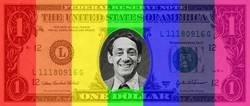America’s gay buying power projected at $743 billion in 2010
-
WASHINGTON – The total buying power of the U.S. lesbian, gay, bisexual and transgender (LGBT) adult population in 2010 is projected to be $743 billion, according to the recently updated analysis.
The estimate was originally derived in a joint study by both Witeck-Combs Communications and Packaged Facts titled, “The Gay and Lesbian Market in the U.S.: Trends and Opportunities in the LGBT Community, 6th edition.”
In 2009, the gay buying power projection in the U.S. was estimated at $732 billion.
This 2010 projection is slightly less than earlier analyses – given that the entire U.S. economy has suffered its worst recessionary consequences (between 2008 and 2010) since the Great Depression began in 1929.
“Buying power projections are frequently a standard business measure for companies and policy decision-makers. This offers us a reasonable snapshot of the projected annual economic activity of America’s diverse gay, lesbian, bisexual and transgender population even in this faltering economy,” said Bob Witeck, CEO of Witeck-Combs Communications.
Since 1993, Witeck-Combs Communications has provided expert marketing and communications counsel to Fortune 500 companies in their strategies to reach the gay consumer market.
Witeck and his co-founder, Wes Combs, also are co-authors of “Business Inside Out: Capturing Millions of Brand Loyal Gay Customers” (Kaplan 2006).
“Buying power is not the same as affluence or wealth. No one should infer that same-sex households are more affluent than others – this is little more than a stereotype, considering the economic evidence available,” Witeck said.
“We have seen research from academic researchers that strongly suggests gay men may earn slightly less than their heterosexual counterparts.”
He added that, “the best available census data on same-sex couples supports the understanding, however, that LGBT households tend to skew in major metro and suburban areas – a characteristic generally associated with higher than average income. And while parenting trends grow, we also see evidence through census snapshots that same-sex couples remain less likely than their married heterosexual counterparts to have kids, and they are more likely to have both partners in the workforce, factors which yield slightly higher per capita household income, especially in the case of gay male couples.”
Nonetheless, Witeck concluded, “we also are well aware that under existing laws and norms, same-sex couples are penalized throughout the economy by discriminatory tax burdens, a hodge-podge of inadequate relationship rights and obligations, complex and costly barriers to adoption and parenting, and barriers to access to public safety net programs that are routinely available to married couples and their families.”
Based on a reasonable and broad range of population samples, the analysis benchmarks between 6 percent to 7 percent of the adult U.S. population who self-identify as gay, lesbian or bisexual, or between 15 and 16 million adults. Unlike estimates of buying power for other populations, such as African-Americans or Hispanics, the projected LGBT population is estimated only among adults over the age of 18 when they are more likely to be fully aware and able to define their sexual orientation or gender identity. For other groups such as African-Americans, Asian-Americans and Latinos, the population total includes all ages.
The method used for this annual economic projection is intended to roughly mirror the accepted approach taken by the Selig Center for Economic Growth at the University of Georgia in its calculation of the purchasing power of niche consumer segments such as Hispanics and African Americans. This methodology uses national aggregate disposable income data that are compiled by the Bureau of Economic Analysis (BEA) of the U.S. Department of Commerce and are therefore considered the most authoritative picture of overall purchasing power in the United States. Gay and lesbian purchasing power is calculated by allocating a proportion of aggregate disposable personal income (DPI) to the gay and lesbian consumer segment.
“Buying power, we know, signals one critical measure of the growth and size of the vital LGBT consumer market,” said Don Montuori with MarketResearch.com. “In our analysis, we are clear to define buying power as another term for ‘disposable personal income,’ which is the total after-tax income available to an individual to spend on personal consumption, personal interest payments or savings. According to economists, today this roughly equals 86 percent of income.”
